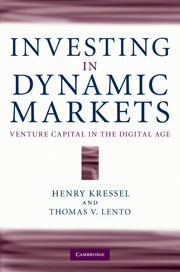Book contents
- Frontmatter
- Contents
- List of figures
- List of tables
- Acknowledgments
- Introduction
- 1 Hot markets, investment waves, bubbles, charlatans
- 2 Financing high-risk businesses
- 3 Venture investing: An uncertain science
- 4 Investing in a transformed market: Telecommunications
- 5 Investing in a transformed market: Semiconductors
- 6 Investing in early-stage technology: The Internet in the 1990s
- 7 Software products and services
- 8 Venture capital: Past and future
- Appendix
- Bibliography
- Index
5 - Investing in a transformed market: Semiconductors
Published online by Cambridge University Press: 06 July 2010
- Frontmatter
- Contents
- List of figures
- List of tables
- Acknowledgments
- Introduction
- 1 Hot markets, investment waves, bubbles, charlatans
- 2 Financing high-risk businesses
- 3 Venture investing: An uncertain science
- 4 Investing in a transformed market: Telecommunications
- 5 Investing in a transformed market: Semiconductors
- 6 Investing in early-stage technology: The Internet in the 1990s
- 7 Software products and services
- 8 Venture capital: Past and future
- Appendix
- Bibliography
- Index
Summary
It may be appropriate to speculate at this point about the future of transistor electronics … It appears to most of the workers that an area has been opened up comparable to the entire area of vacuum and gas-discharge electronics … It seems likely that many inventions unforeseen at present will be made …
You and I and every other person on earth are in debt to armies of tiny electronic servants that make the unparalleled quality of our modern life possible.
In 2009 each of us, no matter where we lived or who we were, had more than 10 billion transistors at our beck and call to help place phone calls, record and play video, reproduce music, conduct international business, even do astrophysical calculations. That is not a worldwide total – it is 10 billion per person. In 2003 there were – I hesitate to say “only” – 100 million per person.
That is astonishing growth, and the end is nowhere in sight. Today the transistor is the core processing unit in electronics. Practically every electronic product now in use is enabled by it.
It has evolved from a discrete device – normally packaged in a steel or plastic canister a little larger than a match head, equipped with three wires for connection into an electronic circuit – into an invisibly small component embedded in a self-contained integrated circuit (IC).
- Type
- Chapter
- Information
- Investing in Dynamic MarketsVenture Capital in the Digital Age, pp. 127 - 157Publisher: Cambridge University PressPrint publication year: 2010



